Demystifying Electrical Installation: Comprehending Codes and Rules for a Legal and Safe Arrangement
In the realm of electric installation, adherence to codes and regulations is vital to ensure both validity and security. The trip to debunking electrical installation goes past simple knowledge with laws; it requires an extensive grasp of how to implement safe electric practices properly.
Significance of Electric Codes
The adherence to electric codes is critical in making sure the safety and integrity of electrical installments. Electric codes offer as a collection of standards and standards that determine the appropriate style, installment, and upkeep of electric systems. These codes are established to minimize the danger of electrical dangers, fires, and other safety and security problems that may arise from malfunctioning electric job.

Additionally, electric codes are consistently updated to incorporate brand-new innovations, best techniques, and precaution. Remaining updated with these codes is crucial for experts in the electric market to guarantee that their job meets the most recent security standards. Inevitably, the relevance of electric codes depends on creating a protected and reliable electrical infrastructure that benefits both people and neighborhoods.
Secret Regulations for Safety And Security
Several basic policies control the safety and security standards in electric installations. One crucial policy is the National Electric Code (NEC), which supplies standards for risk-free electric style, installation, and inspection to secure individuals and property from electric dangers. The NEC covers aspects such as electrical wiring methods, grounding, overcurrent security, and tools setup to ensure a safe electric system.
An additional essential guideline is the Occupational Safety And Security and Health Administration (OSHA) criteria, which concentrate on the safety and security of workers included in electric installations (BRE Electrical). OSHA policies include demands for appropriate training, security treatments, and individual safety tools to avoid office accidents and injuries
Moreover, the International Electrotechnical Commission (IEC) standards intend to balance electrical installation laws on a worldwide scale. These criteria address problems like electrical equipment safety and security, electromagnetic compatibility, and power effectiveness to promote harmony and security in electrical setups worldwide.
Compliance with these vital policies is vital to ensure the security and legality of electric setups, shielding both individuals and residential or commercial property from the risks connected with electrical power.
Understanding National Electric Code
Trick guidelines such as the National Electric Code (NEC) supply important standards for safe electric layout, setup, and examination to ensure the protection of individuals and property from electric threats. The NEC, likewise understood as NFPA 70, is a thorough set of requirements for electric installations that are updated every 3 years. It is established by the National Fire Protection Association (NFPA) and is commonly taken on throughout the United States.
The NEC covers different facets of electrical work, including circuitry methods, grounding, overcurrent protection, and devices setup. It intends to safeguard people and building by dealing with prospective dangers connected with electric systems. Conformity with the NEC is generally implemented by regional authorities having territory (AHJs), such as constructing code authorities and assessors.
Understanding the NEC is essential discover this info here for electrical service providers, developers, and assessors to ensure that setups satisfy the needed security needs. By sticking to the NEC standards, specialists can aid prevent electrical mishaps and make certain the integrity of electric systems in residential, commercial, and industrial setups.

Compliance With Local Building Ordinance
Recognizing and adhering to regional building codes is necessary for ensuring the security and conformity of electrical setups within a specific territory. These codes outline certain needs for electrical setups, such as the kind of circuitry to be utilized, positioning of outlets, grounding techniques, and lots capacities.
When it comes to electrical setups, failing to abide by neighborhood building regulations can lead to severe effects. Non-compliant installments might posture safety and security hazards, increase the danger of electrical fires, and cause expensive fines or legal find more info issues. Furthermore, insurance provider might refuse to cover damages resulting from installments that do not fulfill local building regulations demands. It is necessary for electrical contractors and professionals to stay educated around and strictly stick to the regional building codes relevant to their jobs.
Making Certain Safe Electric Practices
Practicing rigorous adherence to established safety and security procedures is crucial in the area of electrical installations to alleviate potential dangers and guarantee the well-being of individuals and residential properties. Safety in electric work incorporates different aspects, beginning with the appropriate training of personnel involved in installment, maintenance, and repair work. It is necessary to comply with manufacturer directions carefully when managing electrical elements and equipment. Before beginning any type of job, it is vital to perform a complete threat assessment to recognize potential hazards and apply safety nets. Utilizing personal protective devices (PPE) such as shielded handwear covers, shatterproof glass, and non-conductive footwear is non-negotiable to protect against electric shocks and arc flashes. Routine devices assessments, screening, and upkeep timetables are essential to discover and remedy mistakes prior to they intensify right into safety and security risks. Adherence to appropriate lockout-tagout treatments throughout upkeep activities is vital to stop accidental energization of circuits. By prioritizing risk-free methods, electrical installations can function efficiently while minimizing the likelihood of mishaps or damage.
Final Thought
Finally, adherence to electrical codes and laws is critical for making sure more information the safety and validity of electric setups. Understanding the National Electric Code and conformity with regional building regulations are essential for a secure setup. By adhering to these guidelines and practicing secure electrical techniques, individuals can prevent prospective risks and guarantee the correct performance of their electrical systems.